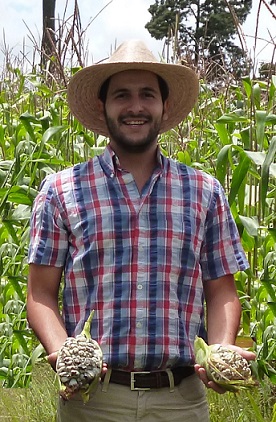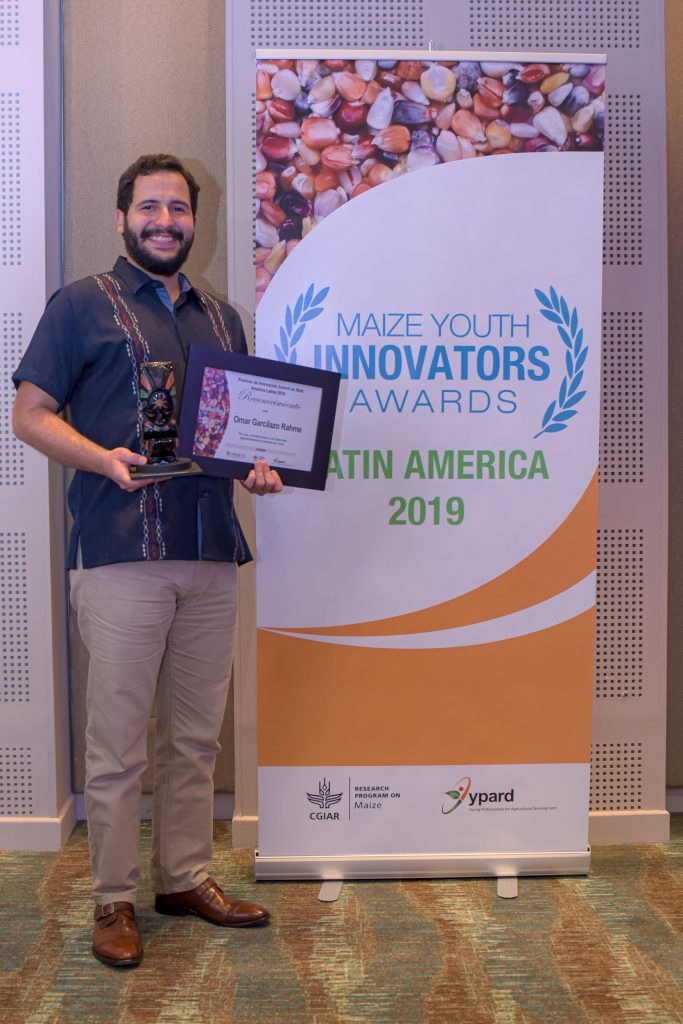
Young researcher brings edible maize fungus to Mexican tables for better nutrition
By Leslie Dominguez and Jennifer Johnson
Omar Garcilazo Rahme works to help smallholder farmers in Mexico improve their nutrition and livelihoods by cultivating huitlacoche, an edible maize fungus prized by consumers and chefs that is considered a delicacy. Omar developed a new and simple technique that would allow farmers to grow the fungus without having to invest in greenhouses or even change anything about their traditional maize production system, with excellent results. He was recently awarded the MAIZE Youth Innovators Award 2019 – Latin America in the category of researcher for his involvement in this work.
The awards, an initiative of the CGIAR Research Program on Maize (MAIZE), seek to recognize the contributions of young women and men who are implementing innovations in Latin American maize-based agri-food systems. This is the third instalment of the awards, following Asia in October 2018 and Africa in May 2019. The awards ceremony took place at the 23rd Latin American Maize Reunion in Monteria, Colombia on October 9, 2019.

Q: What inspired you to work in agriculture?
A: I have always been interested in food quality and food systems. I come from a family of chemists and grew up around science, so I decided to study food engineering and later pursued a postgraduate degree in agro-ecology.
I have worked in the food industry for a long time. What made me focus on agriculture is the global problem we are facing with industrialized foods that can be harmful to health, as well as the limited progress that has been made on including more natural options that help people to have better nutrition. Mexico has huge potential to develop high-quality, healthy products.
I am interested in helping people to have better diets and nutrition, and want to be part of a system that can turn these goals into a reality. Fortunately, I believe that this can be accomplished in part through my innovation, which is just one of many initiatives working towards this goal in my country, Mexico.

Q: Describe your innovation
A: The innovation that I presented was part of my postgraduate research. This innovation consists of incorporating the edible maize fungus Ustilago maydis— or huitlacoche, as it is known in Mexico—into open air maize production systems. Huitlacoche is usually produced in greenhouses under controlled conditions. Our innovation involved finding a simple technique for smallholder farmers to grow this fungus without having to make any changes to their maize production system.
We evaluated the susceptibility of inoculum of Ustilago maydis in open-air maize plantings through a technique that is low cost and accessible to smallholder farmers, as they are the ones who face the greatest barriers to enter the market.
The technique consists of inoculating maize plants using a syringe when the maize plant is just beginning to open its silk channels (beginning of R1 phenology stage). For the innovation to work, you need three things: a high quality inoculum, the right variety of maize and proper climactic conditions to allow huitlacoche to grow in the open air.
From the beginning, the main objective has been to help people consume more nutritious foods and, by adopting the innovation, improve their lives and livelihoods.
Huitlacoche is high in protein, and contains roughly twice as much protein as maize. While maize currently sells at far less than USD$1 per kilo, huitlacoche can go for USD $1 to USD$4 per kilo, a substantial increase. Here we have a plant based protein that can be grown in only 20-30 days using one of the most important crops in the world.
Q: How does it feel to be named a winner of these awards?
A: I feel so excited. When I received the email informing me that I had won I was so shocked and happy, and I am very grateful that my work has been valued and recognized in this way.
I hope that this opportunity allows me and my fellow winners in the researcher, change agent and farmer categories to continue to work and help many more people working in maize based systems.

Q: What are your hopes for the future?
A: I hope to continue working on developing foods that contribute to health, and that we have better tools and high-quality products to have a better diet. Young people are ready to come up with solutions, and we feel responsible to contribute more in terms of innovation and technology.
Mexico shelters a great part of the genetic diversity of maize. It’s not just a crop to us—it is the base of our diets, and plays an important role in our culture and history. We are practically made of maize—we tend to eat maize all day every day.
However, I feel that there is still a lot to be done. I am very glad that there are organizations like the International Maize and Wheat Improvement Center (CIMMYT) that work on maize, a crop that is so important around the world. In addition, maize has so many varied applications and uses that I believe that we can continue to find even more, as it is a plant that has lived alongside humanity for a long time and there are still things that we can learn from it.
Q: What advice do you have for other young people interested in agriculture?
A: If you are interested in agriculture or food systems or want to understand them better, you will need lots of patience, curiosity and a desire to explore. Agriculture today, like all sciences, is interconnected with technological tools. It’s not just about seeds, land and farmers anymore, now it’s about seeds, land, technology and farmers and there is still a lot to develop and understand.
Science has helped to resolve complex themes such as hunger throughout history, it will continue to do so, but it is necessary to turn it towards agriculture, agronomy and food in a more sustainable way.

2019 MAIZE Youth Innovators Awards Latin America, Huitlacoche, Maize, Mexico, MYIA 2019, MYIA 2019 Latin America
